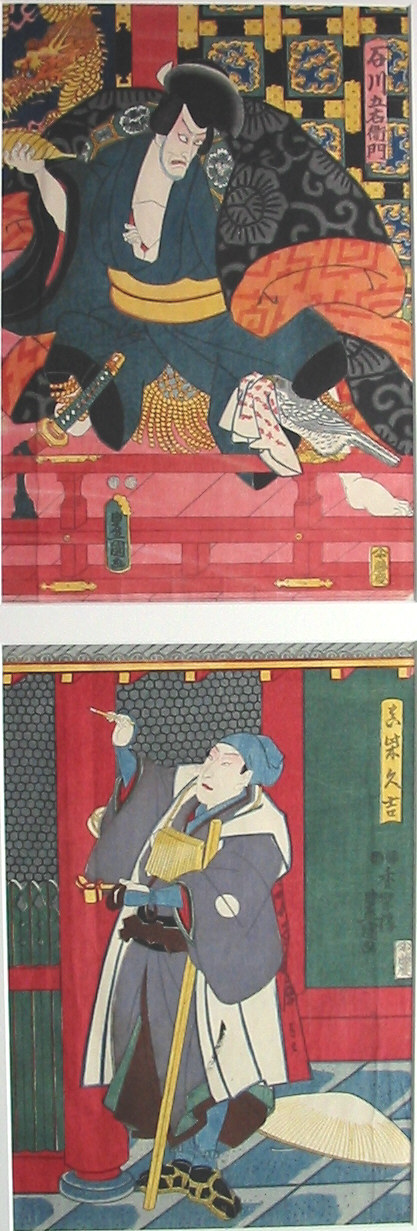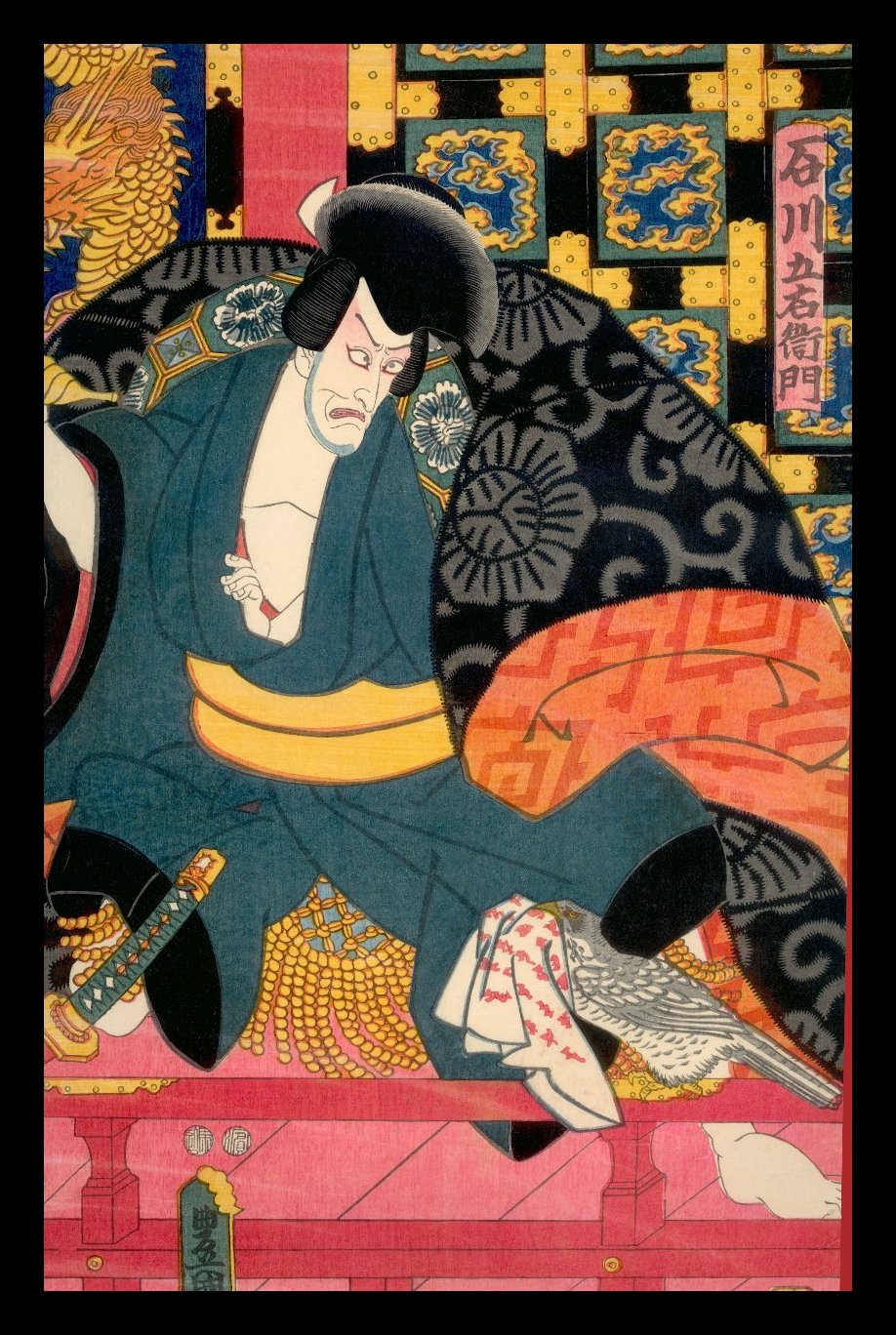
JAPANESE PRINTS
A MILLION QUESTIONS
TWO MILLION MYSTERIES
Ukiyo-e Prints浮世絵版画 |
| Port Townsend, Washington |
|
|
UTAGAWA TOYOKUNI III 三代目歌川豊国 さんだい(目).うたがわ.とよくに 1786-1865 |
|
|
|
Subject: Ishikawa Goemon and Mashiba Hisayoshi |
|
|
|
石川五右衛門 &
真柴久吉 |
|
|
|
Actors:
(Top) Ichikawa Ebizō |
|
|
|
Probably from the play
Sanmon Goemon no Kiri Correction: We now believe the true reading of this title should be Sanmon Gosan no kiri |
|
|
|
Date: 1849-53
(Hama Yahei - 浜弥兵衛 or
はまやへえ) (Magome Kageyu - 馬込勘解由 or まごめかげゆ) |
|
|
|
濱 &
馬込 |
|
|
|
Print Sizes: 14 1/8" x 9 3/4" each |
|
|
|
Publisher: Fujiokaya
Keijirō |
|
|
|
There is another copy of this diptych in the Museum of Fine Arts, Boston. |
|
|
|
$650.00 SOLD! |
|
 |
|
THE GOEMON-BURO 五右衛門風呂 ごえもん.ふろ
(An Eponymous Bath)
There is a version of the legend of Ishikawa Goemon which ends with his capture and being boiled alive. Goemon was said to have been cooked in oil in an iron cauldron. Now you too can reenact that final moment --- sort of. Today you can visit a beautiful site in Japan, commune with nature, live in luxury and slip into a large bath heated from below reminiscent of the one used on Goemon. The difference is you can get out before it gets too hot or too late. You can even put one on your deck or in your backyard when you get home. Oh wait! Thats a hot tub isn't it? However, in Japan this is actually the description of a type of bath which is called a Goemon-buro.
Somehow I just can't get out my mind all of those what are now viewed as politically incorrect cartoons in such magazines as the New Yorker which presented captured big game hunters or explorers who are surrounded by spear-bearing natives while calmly musing about mundane matters.
In The Letters of Lafcadio Hearn (Houghton Mifflin Co., 1910, p. 410) the author wrote: "Do you know that the iron cauldron in which Ishikawa Gogemon [sic] was cooked alive in boiling oil is (said to be) exhibited at the Daibutz temple at Nara? But besides the cauldron you see dried mermaids and dragons - wherefore I do not believe." |
|
HERE IS A DETAIL FOR BETTER VIEWING, BUT WAIT! THERE IS MORE. |
|
|
|
|
|
AND NOW FOR THE MORE PART
Look at the detail of the print shown above. Look hard at the metal-blue robe that the actor is wearing. You could look at it for years, but unless you handled it and turned it slightly in the light you might never notice the dragon. Below is a detail of the that area of the print taken in a strong light, but at an angle. That way the dragon appears like something magical out of the mist. Suddenly you will see its head. But it isn't just a head. It is a full on body. Although my other photos weren't as successful in capturing this we can still give you a moderately reasonable example. |
|
|
|
The image shown below not only displays the back and tail of the dragon on the right side of the actor - your left, but you get a better view of the waves and a few of its sacred Buddhist treasures. The dragon frolics above that in the clouds. This is an ancient and standard Chinese and Japanese motif. I guess you could say that sometimes there are dragons out there, but we don't always notice them. |
.jpg) |
|
WHAT IS WITH THAT BIRD? |
|
|
|
|
|
At the beginning of the scene represented here in this vertical diptych Ishikawa Goemon has stepped out onto the verandah of the Nanzen Temple to view the blossoming cherry trees. He is smoking an oversized pipe. A hawk lands on the railing nearby with a kimono sleeve with characters written in blood in its beak. It records the last request of Soseki in order that his sons might rule in both China and Japan. However, he was slain by Hisayoshi before this could be accomplished. The sleeve states that only the possessor of a special incense called Ranjatai can be his True son. Goemon has that incense and realizes what he must do. (1)
A slightly different and more lucid version --- albeit in French --- is told on a wonderful French web site which deals exclusively with Kabuki. I am sure that many of you are familiar with their contribution. If you are not you should be and should use it as a major resource.
http://www.kabuki21.com/index.htm In their version Goemon, the King of Thieves, has stepped out onto the balcony of the main gate of the Nanzen-ji as described above. He lights his pipe and takes several puffs. The hawk appears with the note written in blood and Goemon realizes that he is Soseki's son and must revenge his death by killing their sworn enemy Hisayoshi. (Hisayoshi is the theatrical character representing Hideyoshi.)
Hisayoshi appears from a trap door in the center below. He is disguised as a pilgrim to the temple . He goes to the temple's basin to purify himself with their waters. It is then that he sees the reflection of Goemon above him. Goemon throws a dagger at Hisayoshi, but is unable to harm him because of the power of the ladle. At the end of the scene Hisayoshi stands staring defiantly up at Goemon. |
|
|
|
(1) New Kabuki Encyclopedia, Samuel Leiter, Greenwood Press, 1997, pp. 551. This account differs considerably from the one provided at John Fiorillo's web site. This is completely understandable, but can be a bit confusing. There are so many different versions of each of the major kabuki plays that it is almost impossible to keep each of them in mind. What is needed is a good concordance. In the 2nd century A.D. a man named Tatian wrote the Diatesseron which was an attempt to bring the four gospels together into one story. While I am not for putting each of the kabuki vesions into a blender we could use something akin to that early Christian text. |

 HOME
HOME